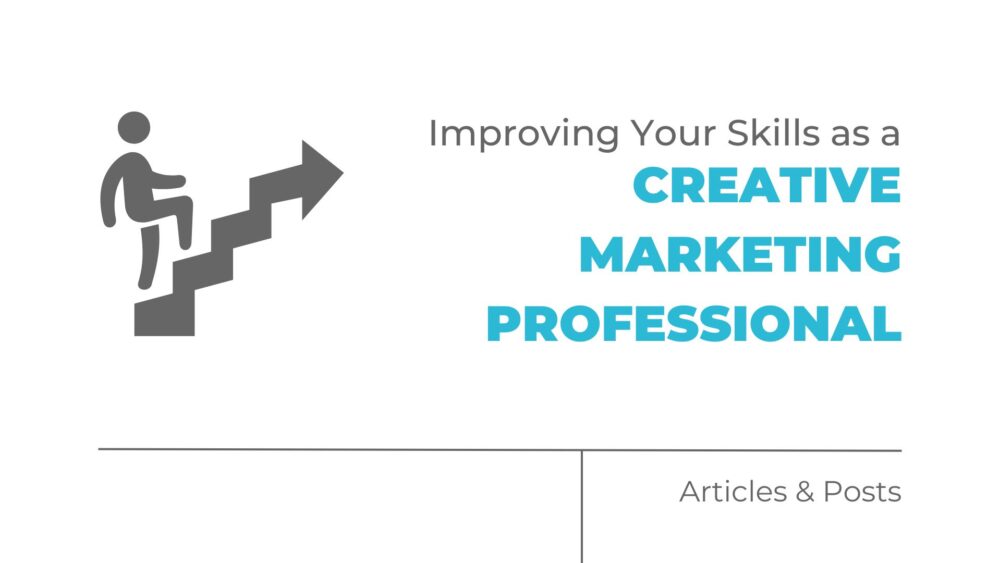As a marketing professional, you need to be creative in order to stand out from your competition.
You need more than one skill.
Improving these professional skills requires dedication and practice, but it is well worth the effort.
You need to be able to think critically, analyze data, and come up with innovative ideas that capture your target audience’s attention.
Having the ability to be creative is essential in creating successful marketing campaigns.
It’s also something we are always aiming to improve at MOCK, the Agency.
With the right approach, you can develop a unique voice that will attract more attention and establish yourself as an expert in your field.
Here are some tips on how to improve your creative thinking and skills as a professional marketer.
As a marketing professional, it is essential to possess creative as well as technical skills in order to make an impact in the industry.
Creative marketing requires more than just basic advertising techniques.
Choosing this career path means your goal is to create and launch engaging campaigns that capture attention.
The ability to think outside the box and come up with out-of-the-box solutions is key to success.
“The creative process is fueled by divergent thinking — a breaking away from familiar or established ways of seeing and doing.” — The Innovator’s Toolkit, Harvard Business Essentials
Other skills that are essential include:
- understanding consumer behavior
- knowing how to leverage technology
- understanding trends and analytics
- developing a unique voice or identity for the brand
- creating content that resonates with customers
- and staying ahead of the competition.
Marketing professions rely on their ability to create content for campaigns that engages customers and help their company stand out from the competition.
Here’s what we will talk more about to help you combine strategy, creativity, and marketing skills to build amazing marketing campaigns that customers love:
Strategy and Creativity
- Breaking it down: what does strategy mean
- Applying Creativity: How to translate big picture strategy into small picture execution
- Bringing Clarity to Marketing Campaigns: Questions to Fuel Creative Thinking
- What’s required to execute on a marketing campaign
- Common places where communication breaks down in marketing campaigns
Marketing Skills
- “Range” the book applied to Marketing Professionals: Specialists die out but multidisciplinary professionals can flex and move forward – more opportunity for those with a diverse set of skills.
- Marketing Skills: How design, advertising and digital interrelate
- A Professional Marketer Needs to be Multifaceted and Well-Versed in Design, Advertising, and Digital
- What you can do when your marketers have a gap in creative skills
Breaking it Down: What Does Strategy Mean
So, how do I learn to be more strategic with creative marketing?
Strategy in marketing refers to the overall plan or approach that a company uses to achieve its goals and objectives.
It involves making decisions about target markets, messaging, budget allocation, and tactics to reach customers.
Being strategic with creative marketing means understanding how your actions and ideas will contribute to the overall strategy and help achieve the desired outcomes.
You can learn to be more strategic with creative marketing by:
- Understanding the company’s goals and objectives
- Knowing your target audience and their behavior
- Identifying key performance indicators (KPIs) to measure success
- Continuously learning and adapting to new trends and technologies
- Collaborating with other departments to align efforts towards a common goal
By being strategic in your approach, you can ensure that your creative ideas are aligned with the overall strategy and contribute to the company’s success.

Applying Creativity: How to translate big picture strategy into small picture execution
One of the key challenges for marketers is translating big picture strategy into small picture execution.
While it may be easy to come up with a grand marketing plan, executing it in a way that effectively engages customers and drives ROI can be more challenging.
To effectively apply creativity in this process, here are some steps to follow:
Understand the big picture
It’s important to have a clear understanding of the overall marketing strategy and goals.
This includes knowing the target audience, messaging, and desired outcomes for your business.
Identify opportunities
Look for areas where creativity can be applied to enhance the marketing plan.
This could include using new social platforms or channels, developing unique content ideas, or implementing innovative tactics.
Collaborate with other departments
Marketing does not operate in isolation.
Collaborate with other departments such as sales, product development, and customer service.
Their perspectives can provide valuable insights and ideas that can make your strategy better and work to bring success to the business as a whole.
Think outside the box
Don’t be afraid to take risks and learn to think outside the box.
Don’t limit yourself to traditional methods or ideas.
Experiment with different strategies and approaches to see what works best for your brand.
Test and measure
It’s important to test and measure the effectiveness of your creative ideas.
Just because it’s a great idea doesn’t mean that its going to get customers on board.
Take the time to evaluate how the campaign is affecting your business and its image.
By following these steps, you can effectively translate big picture strategy into small picture execution, using creativity to enhance the overall marketing plan.
Bringing Clarity to Marketing Campaigns: Questions to Fuel Creative Thinking
Effective marketing campaigns require a clear understanding of the goals, target audience, and messaging.
As a marketer, it’s important to ask the right questions in order to gain clarity on how you can best support your brand or business.
Here are some questions you can ask to bring clarity to your marketing campaigns:
- Who is the target audience for this brand and campaign?
- What are their pain points and how does our business/product/service address them?
- What are the key messages we want to convey through this campaign?
- How will we reach our target audience? What channels or platforms will we use?
- Are there any creative or innovative ideas that could make this campaign stand out?
- How can we measure the success of this campaign in terms of ROI and engagement?
By asking these questions, you can gain a deeper understanding of the campaign and develop creative ideas that align with the overall strategy.
What’s required to execute on a marketing campaign
Executing a successful marketing campaign requires a combination of skills, resources, and processes.
Some key requirements include:
- A solid understanding of the goals and objectives of the bussiness
- Knowledge of your customers and future customers – your target audience and their behavior
- Budget allocation for various marketing efforts
- Collaboration with other departments or external partners to achieve desired outcomes
- The ability to adapt and pivot as needed based on data and insights
- Clear communication and alignment between all stakeholders involved in the campaign
Additionally, having the right tools and technology can also play a crucial role in executing a marketing campaign effectively.
This could include automation software, analytics platforms, or creative design tools.
By having the right resources in place, marketers can streamline their processes and focus on delivering impactful campaigns.
Overall, a combination of strategy, creativity, collaboration, and resources is required to execute successful marketing campaigns.
So don’t be afraid to explore new ideas and approaches, collaborate with others, and continuously measure and adapt to achieve your marketing goals.

Common places where communication breaks down in marketing campaigns
Communication is key in any marketing campaign, and when it breaks down, it can lead to missed opportunities, delays, and even failure. Some common places where communication may break down include:
- Lack of clear goals and objectives: Without a clear understanding of what the campaign aims to achieve, it can be challenging for all stakeholders to align their efforts.
- Misaligned expectations: When expectations are not clearly communicated, it can lead to misunderstandings and confusion among the people in your business.
- Poor communication within the team: Ineffective communication between team members or departments can create bottlenecks and delays in the campaign’s execution.
- Lack of transparency: When information is not shared openly and transparently, it can lead to distrust and hinder collaboration.
To avoid these breakdowns in communication, it’s important to establish clear goals and expectations, promote open and transparent communication within your business, and regularly check in with all stakeholders involved.
By maintaining effective communication throughout the campaign, you can ensure that everyone is on the same page and working towards a common goal.
So how can we improve communication?
Practical Tips for Maintaining Good Communication During a Marketing Campaign
- Establish Clear Goals and Expectations: At the beginning of the campaign, make sure that everyone understands the campaign’s goals and their role in achieving them. This should be communicated clearly and effectively to avoid any confusion later on.
- Regular Team Meetings: Conduct regular meetings to discuss progress, address any issues, and make necessary adjustments to the plan. This will ensure that everyone is on the same page and can help prevent miscommunication.
- Open Communication Channels: Use tools like Slack or Microsoft Teams to maintain open lines of communication. This allows for real-time updates and feedback, which can help improve collaboration and efficiency.
- Clear and Simple Messaging: Avoid using jargon or complex language when communicating with your team. The simpler the message, the easier it is to understand and follow.
- Provide Constructive Feedback: Feedback should not just be a one-way street. Encourage everyone marketing for the business to give and receive feedback to improve the campaign’s execution and results.
- Transparency: It’s important to maintain transparency about the campaign’s progress. Share both successes and failures with the team so that everyone can learn and improve.
By applying these practical tips, you can maintain good communication during a marketing campaign, ultimately leading to better execution and results.

Marketing Skills: how design, advertising and digital interrelate
Marketing is an ever-evolving field, and with the rise of technology and digital media, it has become even more complex.
Today, successful marketers need to possess a diverse set of skills that encompass design, advertising, and digital marketing.
Design skills are essential for creating visually appealing content that grabs the attention of potential customers.
From designing logos and graphics to crafting engaging visuals for social media, having a good eye for design can make all the difference in a marketing campaign.
Advertising skills involve creating persuasive messaging and storytelling that resonates with the target audience.
This includes understanding consumer behavior, conducting market research, and crafting compelling ad copy and content writing.
In today’s digital age, you also need a strong understanding of digital marketing techniques such as SEO, social media marketing, and email marketing.
These more technical skills enable marketers to reach a wider audience, measure engagement, and adapt their strategies accordingly.
Overall, design, advertising, and digital skills are closely intertwined in modern marketing efforts.
By continuously honing these skills and staying updated on industry trends and technologies, marketers can stay ahead of the game and create impactful campaigns that drive results.
So keep learning, experimenting, and evolving to become a well-rounded marketer.
So don’t be afraid to explore new ideas and approaches, collaborate with others, and continuously measure and adapt to achieve your marketing goals.
A Professional Marketer Needs to be Multifaceted and Well-Versed in Design, Advertising, and Digital
Design skills can be acquired and refined through various resources available online.
There are countless tutorials, webinars, and courses on platforms like Coursera, Udemy, or even YouTube, which provide a wealth of knowledge on graphic design principles, color theory, typography, and software like Adobe Suite.
Practice is instrumental, so taking part in design challenges or creating mock-up projects can help in building a robust design portfolio.
For honing advertising skills, understanding consumer behavior and market trends is key.
Courses about marketing and consumer psychology can be very beneficial.
Also, tracking successful advertising campaigns and analyzing their strategies, copy, and visuals can provide significant insights.
Practicing crafting ad copies, perhaps for imaginary products, can also be a helpful exercise in developing this skill set.
Digital marketing is a broad field and learning it can start from understanding the basics of Search Engine Optimization (SEO) and Search Engine Marketing (SEM).
Online resources and certification courses from Google and HubSpot can be quite beneficial.
Skills like email marketing, content marketing, and social media strategy can be mastered with consistent learning and practice.
Creating a blog or managing social media content for a small local business can offer practical experience.
Overall, the key to developing these skills is continuous learning, practice, and patience.

A Quick Word on Social Media
Social media is a powerful tool that can help marketers promote their campaigns in many ways.
It’s like having a big megaphone to reach lots of people and make them interested in what you’re doing.
One way social media helps is by making more people aware of your campaign.
You can create posts that show what your campaign is all about and use ads to target specific groups of people who might be interested.
When people see your posts and share them with their friends, it helps spread the word even more!
Another cool thing about social media is that it lets you talk directly with your audience.
People can comment on your posts, ask questions, and give feedback.
This helps you understand what they like and don’t like, and you can respond to their comments to show that you care. It’s like having a conversation with your customers!
Social media also gives you lots of data to see how well your campaign is doing.
You can look at things like how many people saw your posts, how many liked or shared them, and how many people clicked on your website link.
This information helps you understand what’s working and what you can improve.
So, if you’re a marketer looking to support your campaign, social media is a fantastic tool.
You can use it to reach more people, talk directly with your audience, and learn from the data it provides.
It’s a fun and effective way to make your campaign successful!
Further Reading: “Range” the Book Applied to Creative Marketing Professionals
The book “Range: Why Generalists Triumph in a Specialized World” by David Epstein offers valuable insights for marketers seeking to enhance their skills and excel in their jobs.
Epstein challenges the notion of specializing and argues that a broader range of skills and experiences can actually lead to greater success.
One key concept explored in “Range” is the power of interdisciplinary thinking.
Marketers who possess knowledge and understanding beyond their specific domain can bring fresh perspectives and innovative ideas to their jobs.
By drawing from a diverse range of fields such as psychology, sociology, economics, and even art and literature, marketers can gain a deeper understanding of human behavior, market dynamics, and consumer trends.
This interdisciplinary approach allows them to connect seemingly unrelated dots and uncover unique insights that just might be the tools to give their campaigns an edge.
Moreover, “Range” emphasizes the importance of embracing uncertainty and experimenting with different strategies.
In marketing, there is no one-size-fits-all approach.
It requires continuous learning, adaptation, and the willingness to take risks.
By cultivating a range of skills, marketers can become more adaptable and free to try new things as they face changing market demands.
They can also navigate complex challenges by drawing upon their diverse skill set and applying unconventional solutions from various domains.

Additionally, the book highlights the value of collaboration and diverse teams in driving innovation.
By working with people from different backgrounds and skill sets, marketers can benefit from a range of perspectives and insights.
Collaboration in the workplace also allows for cross-pollination of ideas and approaches, resulting in more creative and impactful campaigns.
What you can do when your marketers have a gap in creative skills
Identifying a gap in your marketing team’s skills is really an opportunity for growth and improvement.
If you find that your team is lacking a set of skills that you need, there are several strategies you can use to keep moving forward.
One approach is training and development. Invest in professional development programs or courses to upskill your existing team members.
Online platforms like Coursera, LinkedIn Learning, or Udemy offer a wealth of courses in various fields of marketing.
Alternatively, you could consider hiring new talent with the specific expertise you need.
Bringing in a fresh pair of eyes can also infuse new ideas and perspectives into your team.
Another option is working with freelancers, consultants or marketing agencies that specialize in the area you’re lacking.
This could be a more cost-effective solution that also brings in expert knowledge and experience.
Finally, fostering a culture of continuous learning and cross-training within your team can prevent future skill gaps.
Encourage team members to share their expertise and learn from each other, thus creating a team that is multifaceted and resilient.
While handling gaps in skills can be challenging, it’s an opportunity to strengthen your team and drive your marketing efforts to new heights.

Guide: Translating Marketing Strategy Into Creative Marketing Execution
Once you’ve crafted a comprehensive marketing strategy, the next step is to use every skill you have to break it down into steps you can actually do.
The process involves several essential steps.
First, you need to understand your strategy inside and out.
Make sure you’re clear on your target audience, your unique selling proposition, and the key messages you want to convey.
Understanding these elements will allow you to create campaigns that resonate with your audience and align with your overall strategy.
Next, brainstorm ideas that align with your strategy.
Don’t limit yourself in the initial stages.
The more ideas you come up with, the more material you have to refine later.
Consider various mediums and channels, such as video, social media, blogs, and emails, and think about how you can use your tools and skills to your advantage.
Once you have a list of ideas, refine them.
Consider how each idea aligns with your strategy, how it fits with your brand identity, and how likely it is to engage your target audience.
This is the stage where you’ll start to see your creative marketing skills translate into action.
Finally, create a detailed execution plan.
This should outline what needs to be done, who will do it, and when it will be done.
It should also include metrics for success, so you can evaluate the effectiveness of your campaigns and make necessary adjustments.
Remember, translating marketing strategy into skillfull action requires a blend of strategic thinking, creativity, and careful planning.
It’s about finding the most engaging and effective ways to convey your key messages to your target audience.
A Beautiful Example
One stellar example of a campaign that effectively translated big-picture strategy into action is Dove’s “Campaign for Real Beauty.”
Launched in 2004, this global campaign emerged from a strategic imperative to differentiate Dove in the crowded beauty market by challenging traditional beauty norms and promoting body positivity.
In the execution phase, Dove showcased real, diverse women rather than professional models in its advertisements, a radical departure from industry norms.
The campaign also incorporated innovative elements such as the “Evolution” video, which revealed the manipulation in beauty advertising.

The used “Real Beauty Sketches,” where an FBI forensic artist drew women as they described themselves and then as others described them, highlighting the contrast and fostering self-confidence.
The campaign was a massive success.
It resonated deeply with consumers, sparked a global conversation about beauty standards, and significantly boosted Dove’s sales.
This exemplifies how a clear, well-executed strategy can lead to a successful marketing campaign.
At the End of the Day
The success of any marketing campaign boils down to a robust strategy effectively translated into creative execution.
This process integrates strategic thinking, creativity, continuous learning, and meticulous planning.
Whether it’s filling a gap in your marketing team’s skills or crafting a compelling campaign, the aim is to resonate with your audience and communicate your brand’s unique value proposition.
As showcased in Dove’s “Campaign for Real Beauty,” a well-executed strategy can ignite global conversations, alter perceptions, and ultimately, drive unprecedented success.

